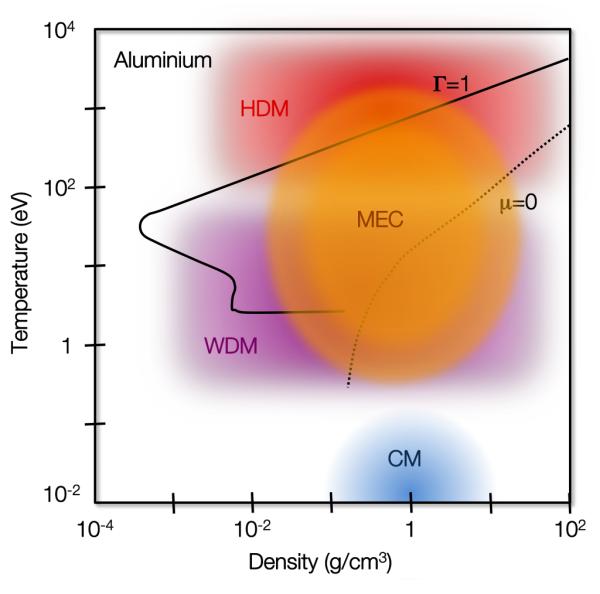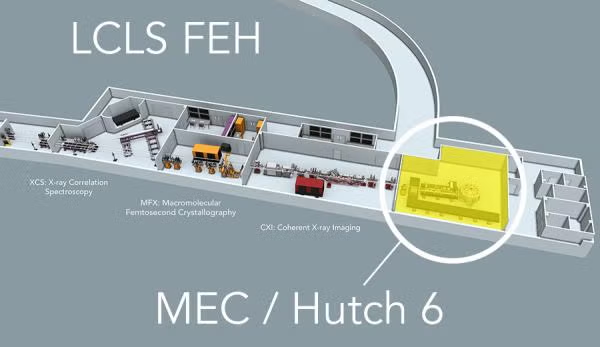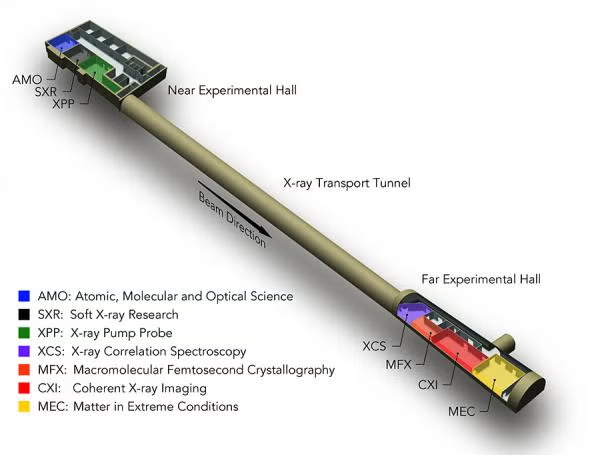MEC Overview
MEC Full Name
Matter in Extreme Conditions Instrument
Short Description
The LCLS beam with its high peak brightness, short pulse duration, and tunable X-ray photon energy provides revolutionary capabilities to study the transient behavior of matter in extreme conditions. The particular strength of the Matter in Extreme Conditions (MEC) instrument is to combine the unique LCLS beam with high power optical laser beams, and a suite of dedicated diagnostics tailored for this field of science (including an X-ray Thomson scattering spectrometer, an XUV spectrometer, a Fourier domain interferometer, and a VISAR system). While the large vacuum target chamber makes the end-station very versatile, it has been designed to service key scientific areas including Warm Dense Matter physics, high pressure studies, shock physics, and high energy density physics.
Scientific Goals

The study of materials under extreme conditions (i.e. high energy density) has in the last decade garnered enormous scientific interest. Three report by the National Research Council [1], the National Science and Technology Council [2] and the National Academy of Sciences [3] identified it as an area where key scientific questions needed to be answered in the new millennium. However, the nature of matter in extreme conditions represent unique experimental challenges. First, such materials generally are generally of high density. This results in a plasma frequency larger than the frequency of available optical laser, and therefore standard laser probing techniques used in plasma physics experiments will not work in this over-dense material. Second, these materials are generally very short lived, and evolve in time rapidly on a femtosecond and picosecond timescale, making the long X-ray pulses of synchrotron facilities a bad match. The LCLS X-ray beam, however, is ideally suited to overcome both these problems. Additionally, its large photon number and exceptional brilliance can allow for both probing the matter using interactions with a low cross-section, or alternatively heating it homogeneously to high temperatures. The MEC end-station is explicitly designed to facilitate such experiments. It will combine a suite of diagnostics and high power lasers, which are standard fare in this field of research, with the unmatched LCLS X-ray beam, to create an instrument that will be at the forefront of, and have a major impact on MEC science.
Scientific Programs
Warm Dense Matter
Warm dense matter is a state of matter that is close to solid density, but with temperatures ranging from a couple of eV to tens of eV. In this state, standard plasma theories are not valid (as the matter is too dense and cold), and neither are solid state theories (since the thermal energy is of the same order as the interaction energies between atoms and perturbative approaches break down). Despite its transient character in laboratory experiments (e.g. inertial confinement fusion experiments), WDM is found abundantly in nature (e.g. cores of large planets [4], stellar accretion disks [3]).
The study of warm dense mater requires the generation of a sample that is uniformly heated to temperatures near and above melt. The method of production can vary from the direct irradiation of a sample by the LCLS [4] or a short pulse laser for thin (1 nm to 100 nm) samples, the irradiation of thicker samples by the LCLS or a long pulse laser on inertially confined samples, or the interaction of ion or electron beams produced by short pulse laser focused to high intensity (>1016 W/cm2).
Hot Dense Matter
The creation of hot dense matter (matter of around solid density and 100s of eV temperature) requires long and/or short pulse lasers to irradiate solid or near solid density material at moderate optical laser intensities (1012 to 1016 W/cm2). In the generic experiment a solid sample is irradiated by a long pulse laser to create a high energy density (HED) plasma, which has ablated from the surface, and a heat conduction wave that moves into the matter both along, and transverse to, the optical laser beam axis. The plasma plume formed in front of the sample varies in density from near solid to dilute plasma. To diagnose the plasma temperature and density one uses a variety of diagnostics, including Thomson scattering5, interferometry, and X‐ray spectroscopy. In addition, specific plasma absorption lines can be pumped to study plasma kinetics.
High Pressure Science
These experiments in their fullest will address a wide variety of topics in high‐pressure research including shocks , equations of state, shock induced chemical reactions, disorder (diffuse scattering), strength/kinetic issues, dislocation dynamics, coupling to large scale molecular dynamics (MD), high strain rate phenomena and shear modulus under compression, (phonon dispersion curves). The generic high pressure experiment has a long pulse laser focused to a target, to a spot size of 150 to 600 μm after having its wavefront smoothed with continuous phase plates. The rear of the target is diagnosed by the VISAR system, which measures the surface motion and the surface reflectivity. These diagnostics are complemented by the XUV spectrometer that measures the fluorescence induced by the LCLS.
References
- R. Davidson, Frontiers in High Energy Density Physics: The X-Games of Contemporary Science, National Research Council, 2003
- Frontiers for Discovery in High Energy Density Physics, Committee on Science by the Interagency Working group on the Physics of the Universe, National Science and Technology Council, 2004
- M. Turner, Connecting Quarks with the Cosmos: Eleven Science Questions for the New Century, National Academy of Sciences, 2003
- B. Nagler et al., Turning solid aluminium transparent by intense soft-X-ray photoionization, Nature Phys. 5, 693, (2009)
- Guillot, T. Interiors of giant planets inside and outside the solar system. Science 286, 72–77 (1999)
- A. L. Kritcher et al., Ultrafast X-ray Thomson Scattering of Shock-Compressed Matter, Science, 322, 69 (2008)
- B. Holian and P.S. Lomdahl, Plasticity Induced by Shock Waves in Nonequilibrium Molecular-Dynamics Simulations, Science 26; 280: 2085‐2088, (1998)
MEC CONTACT INFO
Eric Galtier
Scientist (Instrument Lead)
(650) 926-6227
egaltier@slac.stanford.edu
Ariel Arnott
Area Manager (Instrument)
(650) 926-2604
amarnott@slac.stanford.edu
Jonathan Ehni
SEA (Instrument)
(650) 926-4562
jonehni@slac.stanford.edu
Dimitri Khaghani
Scientist (Instrument)
(650) 926-5009
khaghani@slac.stanford.edu
Hae Ja Lee
Scientist (Instrument)
(650) 926-2049
haelee@slac.stanford.edu
Bob Nagler
Scientist (Instrument)
(650) 926-3810
bnagler@slac.stanford.edu
Philip Heimann
Scientist (Instrument, X-ray Beam Delivery)
(650) 926-8772
paheim@slac.stanford.edu
Nick Czapla
Scientist (Lasers)
(650) 926-4314
nczapla@slac.stanford.edu
Peregrine McGehee
Engineer (Controls)
(650) 926-1631
peregrin@slac.stanford.edu
Nina Boiadjieva
Engineer (Instrument)
(650) 926-4035
ninab@slac.stanford.edu
Marc Welch
Engineer (Lasers)
(650) 926-3754
mwelch@slac.stanford.edu
Control Room: (650) 926-7970
MEC Hutch: (650) 926-7974
Vestibule: (650) 926-7976
MEC LOCATION


